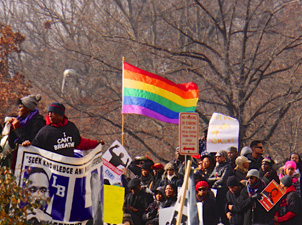
Inclusive Pronouns in NETWORK Email Signatures
NETWORK Communications Team
September 12, 2018
We at NETWORK believe that all people have inherent dignity and worth. Over the past several months and years, we have had internal and external conversations about how we can more clearly articulate that NETWORK is open to all who share our passion. Founded by Catholic Sisters, NETWORK has grown into an inclusive organization that embraces religious diversity, racial justice efforts, LGBTQ+ equality, and more.
One such way NETWORK chooses to articulate our openness to all people is by encouraging staff to share their pronouns in their email signatures. There are several reasons to include pronouns, but at the core, this is rooted in respect and love for each member of our community.
Examples of pronouns that you may see added to our email signatures:
- He/him/his
- She/her/hers
- They/them/their
We should also mention that NETWORK uses singular ‘they’ for inclusivity and brevity rather than he/she when gender is unknown. Read more about the use of singular ‘they’ in the AP Style Guide.
This is a way to let others know that we will not make judgments about anyone’s identity. We recognize that assigning pronouns to others (thereby choosing an identity for them) is presumptuous and can unintentionally cause harm. Choosing to clarify our own pronouns lets other people know how we want to be addressed, and it also holds us accountable to do our best in not making assumptions about other people.
As the Human Rights Campaign explains, “Because gender identity is internal — an internal sense of one’s own gender — we don’t necessarily know a person’s correct gender pronoun by looking at them. Additionally, a person may identify as genderfluid or genderqueer and may not identify along the binary of either male or female (e.g. “him” or “her”). Some people identify as both masculine and feminine, or neither. A genderqueer or non-binary identified person may prefer a gender-neutral pronoun such as the “they” (e.g. “I know Sam. They work in the Accounting Department”). … It’s important to remember that gender identity is not visible — it’s an internal sense of one’s own gender. While most people align across their birth-assigned sex, their gender identity, their gender expression and how everyone else interprets their gender — some people do not. A culture that readily asks or provides pronouns is one committed to reducing the risk of disrespect or embarrassment for both parties”
We know that gender norms and privileges permeate our society. When you see our pronouns in our email signatures (and other places), know that it is an indication that we recognize and affirm the diversity of gender identities and expressions.
And, sometimes people misidentify pronouns for other people they have never met in person— particularly if there are cross-cultural differences. Cultural and personal variations of gender expression in dress and presentation can also create false assumptions, regardless of identity. Sharing pronouns can also be helpful in these scenarios to ensure we address people correctly.
Proactively declaring pronouns is a small action we can take to convey our belief that all people are created in God’s image. NETWORK views this as another way that we may live out our mission of promoting justice and the dignity of all. We encourage other members of our community to make similar changes.
One of the most fundamental ways we can show respect and love for one another is to consciously use language that affirms each other’s identities. We continue looking for ways that we can be more conscientious and more inclusive in our communication. Thank you for your continued support as we strive to make the world more just, together.
If you are interested in learning more about proactively declaring pronouns, here are some additional resources:
Human Rights Campaign: Talking About Pronouns in the Workplace
GLSEN: Pronouns in Email Signatures







